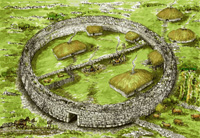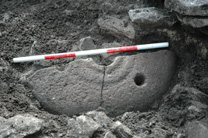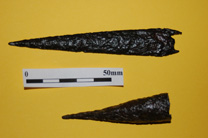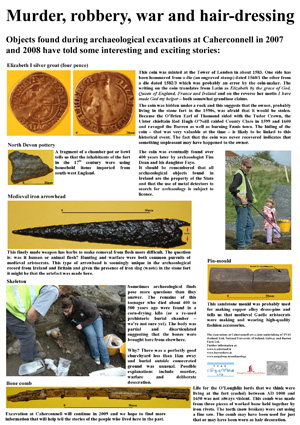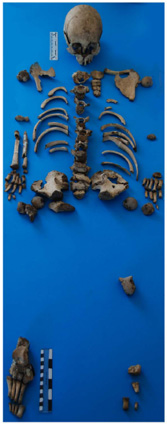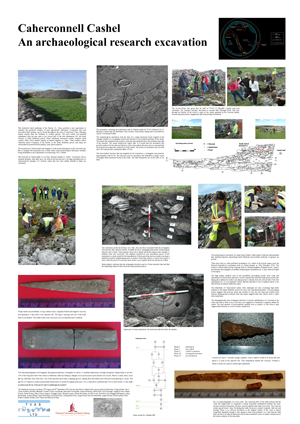Caherconnell, County Clare
The final excavation report for the 2008 and 2009 excavation at Caherconnell is here.
The investigation found a Bronze Age house, an enigmatic medieval burial and a medieval stone structure. Artefacts include Neolithic and Bronze Age pottery, stone axes, thousands of stone tools, medieval coins, a decorated copper alloy pin and iron knives.

Archaeological excavation at Caherconnell, Heritage Week 2008

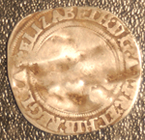
The possible burial chamber showing skeletal remains in the passage (left) and an Elizabeth I silver "groat" minted 1560-61 (right).
Within the chamber, no human remains were found, although there were the skeletal remains of five juvenile pigs.
Three silver coins were recovered from the topsoil which date to between the early 14th and later 16th century.
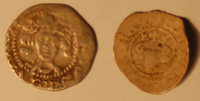
Edward III 2silver pennies minted in Canterburry and Durham 1327-35 and 1344-51 respectively

Reverse of Edward III coins
Also found in the 2008 excavation was a piece of North Devon gravel tempered Ware. This large vessel (perhaps a chamber pot) was made in Barnstable/Bideford in the 17th century and together with the coins, the dated burial and the results of the 2007 excavation adds significantly to the nation that Caherconnell Cashel was occupied through the medieval period into the post-medieval period.
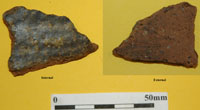
North Devon gravel tempered Ware
The archaeological material has been cleaned and sent to specialists for reporting and a number of radiocarbon dates has been obtained. An archaeological report has been sent to the National Monuments Service of the Department of the Environment, Heritage and Local Government and to the National Museum of Ireland.
In 2008, a second season of excavation took place at Caherconnell Stone Fort in the Burren, Co. Clare.
The excavation was a collaboration between TVAS (Ireland) Ltd, Dr Michelle Comber, NUI Galway and Burren Forts Ltd. The team comprised volunteers including professional archaeologists and members of the public.
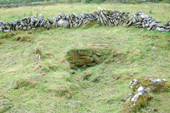
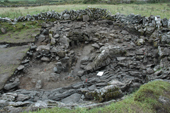 General view of the site showing chamber in hollow
General view of the site showing chamber in hollowThe excavation was targeted at what was thought to be a souterrain chamber located 50m south of the cashel.
The excavation quickly showed that the site was not a souterrain at all, revealing instead a drystone circular chamber with a short passage. Hundreds of lithics and stone tools were found that share many similarities with finds from nearby Roughan Hill and Parknabinia, excavated by Dr Carleton Jones.
We also recovered two pieces of prehistoric pottery and a broken polished stone axe head. Pottery from a decorated Early Bronze Age vessel and more from another vessel of Western Neolithic Tradition dated c. 2500-2000 BC
The chamber may represent a type of prehistoric tomb unique in the Irish archaeological record.
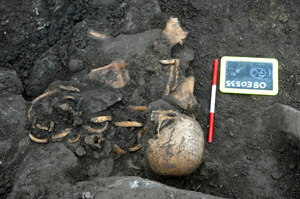 Medieval disarticulated partial burial
Medieval disarticulated partial burialAt least two human burials were found in the chamber passage. One is represented by a skull fragment and the other is of a disarticulated and partial skeleton, probably of a young woman aged 15.
This burial has been radiocarbon dated to AD 1430-1630.
Caherconnell, Summer 2007
A limited archaeological research excavation at Caherconnell cashel, Co. Clare (CL009-03010) was carried out following discussions between the landowner (John Davoren), licensed archaeologist (Graham Hull) and NUI Galway lecturer (Dr Michelle Comber) in the summer of 2007.
The excavation, reporting and publication are being funded jointly by TVAS (Ireland) Ltd, Michelle Comber and the landowner John Davoren through Burren Forts Ltd. All fieldwork labour was given free. Tools, equipment and logistics were provided by TVAS (Ireland) Ltd. Post-excavation processing of finds and samples was provided by TVAS (Ireland) Ltd. Specialist reporting is being financed, where needed, by TVAS (Ireland) Ltd. Four gratia radiocarbon dates were provided by Queen’s University, Belfast (thanks to CHRONO Ringfort Dating Project). Conservation of artefacts is being funded by Burren Forts Ltd.
The excavation was coincided with ‘Heritage Week’ in September 2007 and, through the facility of the visitor’s centre owned by the Davoren family, ensured maximum public engagement with archaeological fieldwork.
A hand-dug trench (5m x 1m) was targeted at the vestigial remains of a rectangular stone-built structure in the northern quadrant of Caherconnell Cashel. The research excavation produced evidence of a wall, door and floor associated with the rectangular structure that was sealed by tumble. Beneath the floor, stratigraphically earlier archaeological deposits were located. These deposits were rich in faunal and floral remains and a number of artefacts were also recovered. The artefacts included an iron arrowhead, pieces of two quernstones, a stone-mould for the manufacture of dress-pins from precious metal, iron slag, a sandstone possible metalworking anvil, a number of nail like objects, an as yet unidentified conical iron object, a bone comb, the point of a bone pin, hone-stones, a poor quality chert tool and pieces of flint.
Radiocarbon dates have been obtained for the deposits beneath the floor. These are AD 1044-1099, 1119-1142 and 1147-1210 (UBA-9068 wto sigma) below the floor and AD 1017-1188 and 1199-1206 (UBA-8563 two sigma) and AD 1400-1525 and 1558-1631 (UBA-8565 two sigma). Radiocarbon dates have also been obtained for the construction of the cashel AD 901-916, 967-1046, 1090-1121 and 1139-1149 (UBA-8564 two sigma) and for the floor of the structure AD 1442-1525 and 1556-1632 (UBA-8562).
These dates suggest that the cashel was probably constructed sometime between the early 10th century and the mid 12th century (in so far as evidence from a single, small trench can reflect activity throughout the entire site). This is corroborated by occupation material that dates to between the early 10th century and the early 13th century. There is a hiatus in the excavation record between the early 13th century and the end of the 14th century. After this gap in the record, further occupation debris was deposited and the rectangular structure within the cashel was built and occupied sometime between the early 15th century and the mid 17th century.
The final report is available here
Read more
